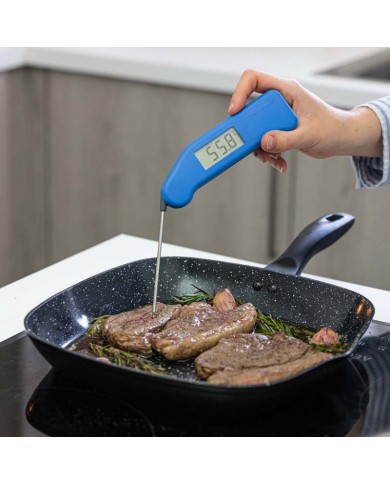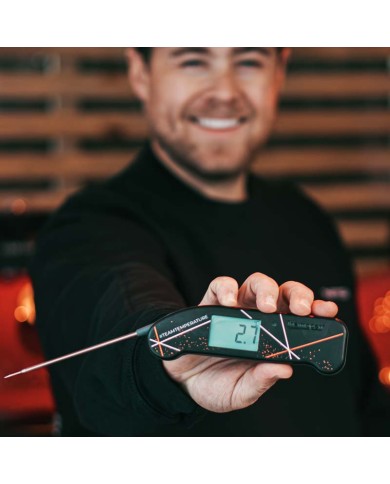How to Cook the Perfect Turkey
Fed up of dry and overcooked Christmas turkey?
We carried out an experiment to find out exactly how to cook and rest your festive bird to ensure a juicy and delicious result.
We cooked three turkeys: one to the time indicated on the packaging, one cooked to 74 °C (the safe temperature for turkey) and one to 67 °C.
Here are the results:
The packet instructions said to cook the turkey for 4 hours and 10 minutes. When we removed it from the oven, its internal temperature measured 97 °C — this is a massive 23 °C higher than necessary.
The result? Bone-dry meat with an unpleasant texture and lack of flavour.
We cooked the second turkey to 74 °C, the safe and optimal temperature for your bird to reach before eating. It only took 1 hour and 20 minutes for it to reach 74 °C — an overwhelming 2 hours and 45 minutes quicker than the time indicated on its packaging.
However, once meat is removed from the heat, it continues to rise in temperature before it starts to drop. This phenomenon is called carryover cooking. This means that our perfectly cooked turkey actually reached a peak temperature of 80 °C while it rested, making it not quite as juicy as it could have been.
Knowing that turkey carryover cooks by around 5-10 °C as it rests, we decided to cook one last bird. We removed the final turkey from the oven when it reached an internal temperature of 67 °C, hoping that it would climb to 74 °C as it rested. And it did.
This turkey reached a safe temperature while it rested, without losing any precious juices. It was by far the juiciest, most tender and flavourful result.
How to Cook the Best Turkey
The results from our experiment showed that the best way to cook a turkey is to monitor the internal temperature and remove it from the oven when it reaches 67 °C in the thickest part. Probe it all over with an instant-read thermometer, like a Thermapen, to ensure it has reached 67 °C all over, then leave it to rest.
Continue to monitor the temperature as it rests to ensure it climbs to 74 °C, and to know when it’s time to carve. We recommend carving your bird once the temperature drops to around 65 °C — this takes a minimum of 45 minutes, but usually around 1 hour 30 minutes, giving you plenty of time to prepare your trimmings.
Top Temperature Tips for Cooking a Juicy Turkey
Defrost
Defrost your turkey safely — give it plenty of time to defrost in the fridge, and never leave it sitting at room temperature. The ideal temperature before cooking should be between -1 °C/30 °F and 4 °C./39 °F
Cook to temperature
The temperature for cooked turkey in the UK is 74 °C. Use a turkey thermometer to check the internal temperature of your bird and ensure it reaches this temperature.
Rest
Resting your turkey for up to an hour will make the meat more tender and juicy. The temperature will continue to rise as it rests, so for an even juicier bird, remove from the oven at 67 °C/153 °F. After resting, the turkey's internal temperature will have reached a safe 74 °C.
UK's Best Turkey Thermometers
Cooking your Christmas dinner to temperature is the best trick for removing the stress and producing your best bird yet. It eliminates worrying about whether it's safe or dreading it being dry. And by investing in a good quality, fast and accurate meat thermometer for turkey, not only will you have the perfect Christmas, but you'll also have a reliable tool for ensuring delicious meat all year round.
No more guessing your turkey's internal temperature. This guide will talk you through the best turkey thermometers and recommended turkey temperatures.
Types of Meat
Thermometers for Turkey
Which Turkey Thermometer is for You?
There are two different types – instant-read turkey thermometers and leave-in thermometers that will make your festive meal succulent and stress-free. If you choose just one, we'd suggest an instant-read thermometer.
Whether you're looking for something simple to take the stress out of the day or a high-tech gadget to make your meal a breeze, we've got options for every kind of cook.
Best Meat Thermometer
Probes for Turkey
An instant-read meat thermometer will tell you if your bird is done in an instant. It's essential to probe whole birds all over to make sure they're completely safe, and a fast-reading thermometer makes this easy. Plus, turkeys can overcook in seconds — an accurate turkey thermometer will ensure it doesn't end up overdone and dry.
All of our thermometers have the speed and accuracy to take on the all-important turkey. Plus, their sleek and easy-to-use designs mean there's no faffing around when it matters most.
Best Leave-in Turkey Thermometer
Choose between our simple alarm option, Bluetooth meat thermometer, or timer and thermometer in one. Each features magnetic backing for attaching to your oven door or BBQ lid.
A leave-in meat thermometer will monitor the temperature of your turkey and alert you when it's done. Simply insert the probe, set the temperature, and watch it climb. Make sure to spot-check with an instant-read afterwards.
Turkey Thermometer Gift Sets
Get the best of both worlds with our limited-time Christmas gift sets. The Thermapen and DOT bundles include both thermometers for ensuring turkey perfection, plus two accessories, all with up to £25 saving.
Turkey Cooking Faq
Give it plenty of time to defrost in the fridge, and never leave it sitting at room temperature.
Always defrost your meat in the fridge. If you don't, you risk the outside of the turkey reaching room temperature, where bacteria thrive, while the centre remains frozen.
Plus, your turkey must be uniform in temperature, or it will not cook evenly, and the outside will be dry.
The best way to safely prepare a frozen bird is by giving it plenty of time to defrost in the fridge. The internal temperature before cooking should be between -1 and 4°C.
There's no length of time that you can cook a turkey to where you can be sure that it's safe and succulent. This is because they vary so greatly in size and because oven temperatures are often different.
Turkey is safely cooked once it reaches a specific temperature that destroys all bacteria in the meat. Cooking instructions usually overestimate the time it takes to cook meat to ensure it reaches this temperature. But this often means it will go way over its ideal temperature and become overcooked and dry. Using a turkey thermometer will mean you don't have to prematurely cut into your turkey and also you will not have to rely on whether or not its juices run clear. The only way to cook a delicious turkey is to temperature, not time.
To measure the internal temperature of turkey correctly, first, you should locate the thickest part of the breast, then spot-check all over. It’s crucial to find the bird’s coolest point to ensure all of the meat is safe to eat.
With your turkey laid flat, start from either the left or right of the neck cavity. Insert the probe horizontally, aiming for the centre of the breast. Make sure to avoid bones or gristle, as they will not give an accurate reading of the meat temperature.
Once you have done this, make sure to check the breast in a couple of places on both sides to confirm it’s reached 74 °C throughout.
For a safely cooked turkey, the internal temp in Celsius is 74 °C. At this temperature, all harmful bacteria will be destroyed, but the meat will still be nice and juicy.
The temperature continues to rise as it rests. So, for the ultimate juicy bird, cook your turkey to around 67 °C, then leave it to rest for up to an hour. During this time, the temperature will reach a safe temperature of 74 °C, and you’ll preserve all the delicious juices.
People usually overestimate cooking times, and checking whether the juices run clear is often unreliable. The best way to make sure your turkey is safe to eat, but still juicy and delicious, is to cook it to temperature.
There are two key steps to getting a lovely crispy skin on your turkey.
Firstly, you should dry brine the turkey before cooking. Dry brining simply means rubbing salt all over the skin ahead of roasting the turkey. This is because it fills the turkey with a delicious salty flavour whilst drying out the skin.
To dry brine your turkey, pat the skin dry with kitchen paper. You can add other flavours to your salt mix and rub it all over the skin for up to two days before cooking the turkey. The longer you leave it, the more intense the flavours will be. Cover it with plastic wrap before popping it back in the fridge.
The other key step to getting a crispy skin is to ensure not to cover it during the rest. Wrapping it in foil will trap in all the hot, damp air, making your skin soggy. Ensure to rest uncovered and you'll have a crispy crust and juicy centre.























